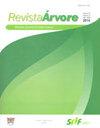NATIVE CAATINGA SPECIES FOR THE RECOVERY OF DEGRADED AREAS IN THE BRAZILIAN SEMIARID REGION
IF 0.8
4区 农林科学
Q4 FORESTRY
引用次数: 1
Abstract
ABSTRACT This study aimed to prospect, among the species that grow spontaneously in compacted landfills, native Caatinga plants with potential for ground cover in extremely impacted areas, with exposed soil. Initially, a general floristic survey was carried out in the four study areas. To prospect the species, data referring to the richness, coverage, and densification of plants in the herbaceous stratum were collected in each study area, using the method of plots. The selection was based on species-specific characteristics: origin, plant habit, life cycle, propagation, dispersion syndrome, coverage, densification, and allelopathic effect. The general floristic inventory revealed the presence of 73 species belonging to 63 genera and 26 botanical families. In the survey of the coverage and densification of the herbaceous stratum, 33 species belonging to 32 genera and 16 families were found, being the most representative: Fabaceae (5), Malvaceae (5), and Poaceae (5). As for the origin, 26 are native, one is naturalized, and six are exotic, of which 66.6% are in the Poaceae family. Moreover, most of these species are herbs, with an annual life cycle, dissemination through seeds, and present autochoric dispersion. The coverage and densification of these species ranged from 0.44% to 9.5% of the area and 1 to 4.44 of individuals/m2, respectively. The species Senna uniflora, Rhaphiodon echinus, Sida galheirensis, Mesosphaerum suaveolens, Hexasepalum teres, Waltheria rotundifolia, Trianthema portulacastrum, and Herissantia crispa showed potential for use in recovery plans for degraded areas based on the results presented by each of them in the parameters analyzed, especially in coverage, densification, dispersion syndrome, and life cycle.巴西半干旱区退化地区恢复的原生caatinga种
摘要/ ABSTRACT摘要:本研究旨在寻找在土壤暴露的极端受影响地区自然生长的原生Caatinga植物。首先,在四个研究区进行了植物区系调查。采用样地法,对各研究区草本层植物的丰富度、覆盖度和密度等数据进行了采集。选择的依据是种特异性特征:来源、植物习性、生活期、繁殖、分散综合征、盖度、密度和化感效应。植物区系调查结果显示,共有植物26科63属73种。在草本层盖度和密度调查中,共发现16科32属33种,最具代表性的是豆科(5科)、锦葵科(5科)和禾本科(5科)。来源方面,本地26种,归化1种,外来6种,其中禾科占66.6%。此外,这些物种大多是草本植物,具有一年生周期,通过种子传播,并表现出自适应的分散。盖度为0.44% ~ 9.5%,密度为1 ~ 4.44个/m2。综合各参数分析结果,单叶泻泻、棘皮草、野田菊、藜草、藜草、圆叶草、圆叶草、马齿苋和黑蕊草在退化区恢复计划中具有一定的应用潜力,特别是在覆盖度、密度、分散综合征和生活期方面。
本文章由计算机程序翻译,如有差异,请以英文原文为准。
求助全文
约1分钟内获得全文
求助全文
来源期刊

Revista Arvore
FORESTRY-
CiteScore
1.00
自引率
0.00%
发文量
32
审稿时长
4-8 weeks
期刊介绍:
A Revista Árvore é um veículo de comunicação científica da Sociedade de Investigações Florestais – SIF. O jornal é de acesso gratuito, revisado por pares, que publica bimestralmente trabalhos científicos originais no campo da Ciência Florestal. As áreas temáticas para publicação são: Ambiência e Conservação da Natureza, Manejo Florestal, Silvicultura e Tecnologia da Madeira e Utilização de Produtos Florestais.
A política editorial visa manter alta conduta ética em relação à publicação e aos seus funcionários, rigor na qualidade dos artigos científicos, seleção de revisores qualificados, respeito profissional aos autores e processo de tomada de decisão imparcial. A Revista Árvore publica artigos apenas em inglês.
Artigos de revisão podem ser publicados se houver uma discussão relevante resumindo o estado da arte sobre o assunto. A revisão estrita da literatura não é aceita.
 求助内容:
求助内容: 应助结果提醒方式:
应助结果提醒方式:


